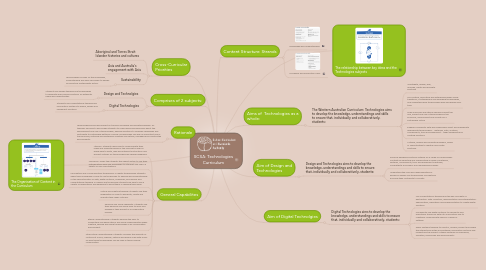
1. The Organisation of Content in the Curriculum
2. Cross-Curricular Priorities
2.1. Aboriginal and Torres Strait Islander histories and cultures
2.2. Asia and Australia's engagement with Asia
2.3. Sustainability
2.3.1. Technologies focuses on the knowledge, understanding and skills necessary to design for effective sustainability action.
3. Comprises of 2 subjects:
3.1. Design and Technolgies
3.1.1. Students use design thinking and technologies to generate and produce solutions for authentic needs and opportunities
3.2. Digital Technologies
3.2.1. Students use computational thinking and information systems to define, design and implement solutions.
4. Rationale
4.1. Technologies enrich and impact on the lives of people and societies globally. As teachers we seek to encourage students to make discerning decisions about the development and use of technologies, develop solutions to complex challenges and contribute to sustainable patterns of living. Technologies can play an important role in transforming, restoring and sustaining societies and natural, managed and constructed environments
5. General Capabilites
5.1. Literacy: Students learn how to communicate their ideas and understandings of the concept as well as being able to write, read and interpret instructions and project outlines for technologies like labelled diagrams.
5.2. Numeracy: Gives the students the opportunities to use their mathematical skills and knowledge to interpret and use in a variety of real-life situations.
5.3. Information and Communication technology: In digital technologies students apply their knowledge of how to use technology to develop and understanding of the characteristics of data, digital systems, audiences, procedures and computational thinking. In design and technology students are able to use a variety of applications and hardware to assist them in realising their ideas.
5.4. Critical and creative thinking: Students use their imagination in order to generate, create and evaluate their ideas critically.
5.5. Personal and social capability: Students use their personal and social skills to work and engage in their project in a collaborative manner.
5.6. Ethical understanding: Students develop the skills to understand and apply ethical and social responsibilities when creating, sharing and using technologies in an collaborative environment.
5.7. Intercultural understanding: Students consider the diversity of cultures at a local, regional, national and global scale with focus on how these technologies can be used in these varying communities.
6. The relationship between key ideas and the Technologies subjects
7. Aims of Technologies as a whole:
7.1. The Western Australian Curriculum: Technologies aims to develop the knowledge, understandings and skills to ensure that, individually and collaboratively, students:
7.1.1. Investigate, design, plan, manage, create and evaluate solutions
7.1.2. Are creative, innovative and enterprising when using traditional, contemporary and emerging technologies, and understand how technologies have developed over time
7.1.3. Make informed and ethical decisions about the role, impact and use of technologies in the economy, environment and society for a sustainable future
7.1.4. Engage confidently with and responsibly select and manipulate appropriate technologies − materials, data, systems, components, tools and equipment − when designing and creating solutions
7.1.5. Critique, analyse and evaluate problems, needs or opportunities to identify and create solutions.
8. Aim of Design and Technologies
8.1. Design and Technologies aims to develop the knowledge, understandings and skills to ensure that, individually and collaboratively, students:
8.1.1. Produce designed solutions suitable for a range of Technologies contexts by selecting and manipulating a range of materials, systems, components, tools and equipment creatively, competently and safely; and managing processes
8.1.2. Understand the roles and responsibilities of people in design and technologies occupations and how they contribute to society.
9. Aim of Digital Technolgies
9.1. Digital Technologies aims to develop the knowledge, understandings and skills to ensure that, individually and collaboratively, students:
9.1.1. Use computational thinking and the key concepts of abstraction; data collection, representation and interpretation; specification, algorithms and implementation to create digital solutions
9.1.2. Confidently use digital systems to efficiently and effectively transform data into information and to creatively communicate ideas in a range of settings
9.1.3. Apply systems thinking to monitor, analyse, predict and shape the interactions within and between information systems and understand the impact of these systems on individuals, societies, economies and environments.
